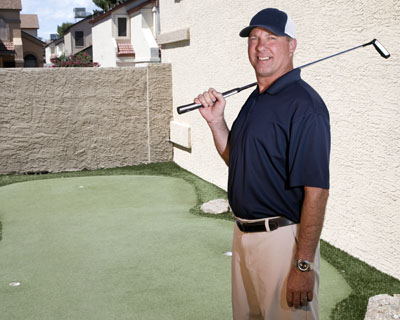Tom's Rotator Cuff Story
May 28, 2019 Tom Stuckenschneider has always enjoyed being active, whether shooting a few hoops, playing a round of golf, or running the bases.
Tom Stuckenschneider has always enjoyed being active, whether shooting a few hoops, playing a round of golf, or running the bases. Over the years, he’s had a tumble or two. But he’d quickly recover and get right back to playing. That all changed in March. While diving to catch a softball during an Over-The-Line tournament, Tom hit the ground hard, injuring his right shoulder.
The Phoenix resident had fallen on that same shoulder playing baseball during his teens and 20’s, but the shoulder had always healed on its own.
But now, at age 51, something had changed, and he couldn’t shake the severe pain from the fall. His wife took him to the Abrazo Scottsdale Campus emergency room and although an X-ray revealed he hadn’t broken any bones, his pain and decreased shoulder function persisted.
Tom sought help from Dr. Emily Schwartz, a primary care sports medicine physician on staff at Abrazo Scottsdale Campus. She did an evaluation of his shoulder, determined it was a rotator cuff tear, and ordered an MRI for surgical planning. She referred him to Dr. Dana Seltzer, an orthopedic shoulder surgeon on staff at Abrazo Scottsdale Campus.
Dr. Seltzer explained to Tom that he had a massive rotator cuff tear. Three tendons in the rotator cuff of his shoulder were torn, and his shoulder injury wouldn’t heal, this time, without surgery.
Tom discovered he was one of about 2 million people in America suffering from rotator cuff problems. “Full thickness rotator cuff tears do not heal on their own, but some can be managed without surgery by using a well-designed conservative treatment program,” said Dr. Seltzer.
“Tom was unlucky in having a complete rotator cuff tear, but most rotator cuff tears are partial and many are preventable,’’ said Dr. Schwartz. “Preventing a rotator cuff injury is much less painful than treating one.’’
“Regular shoulder exercises can not only strengthen muscles and tendons, but also protect the shoulder’s range of motion. Other ways to help prevent injury include maintaining good posture and taking breaks at work or play to rest the shoulder if the job or activity is physically demanding,’’ she said.
But for some patients, like Tom, surgery is the best option for improved recovery. “Not all rotator cuff injuries require surgery, but substantially decreased shoulder function with loss of range of motion immediately after an injury are generally signs of a poor prognosis for non-operative treatment,” according to Dr. Seltzer.
His goal was to regain his active life as soon as he could. He had been keeping up a busy sporting schedule – three rounds of golf a month and six over-the-line softball tournaments a year.
“Sports is in my blood. I grew up with my father playing golf. I started playing baseball at age 6. Put a glove or bat in my hand and I’d be loving it,’’ Tom said.
As he aged, he modified his activities, moving from playing baseball to softball and now, Over-The-Line softball. The last thing he wanted, after his injury in March, was to be sidelined long term, so he opted for the surgery.
It took several hours to repair his injured shoulder. He was out of the hospital 24 hours later and back at work five days after that. His job, designing putting greens and artificial lawns, lets him pace himself.
As part of his postoperative recovery, Tom applies ice regularly and uses a pulley daily to regain range of motion in his shoulder.
“I know that healing is a long process, but I am gaining more mobility each day. It’s been a month since surgery and I’m doing well,’’ he said.
Tom is looking forward to starting physical therapy soon to improve his shoulder’s strength and function. His goal is to be able to swing a golf club again soon.
“I’m encouraged that I won’t feel pain in the future. I don’t know if I’ll be able to play ball again, but I look forward to playing golf more,’’ he added.
Disclaimer: Dr. Emily Schwartz and Dr. Dana Seltzer are independent physicians and are not employees, agents or representatives of Abrazo Scottsdale Campus. They are solely responsible for the provision of his medical services to their patients.
